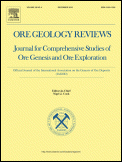 A
Re–Os
isotope
study of sedimentary rocks and
copper–gold ores from the Ertsberg District, West Papua, Indonesia
A
Re–Os
isotope
study of sedimentary rocks and
copper–gold ores from the Ertsberg District, West Papua, Indonesia
Mathur, Ryan; Titley,
Spencer; Ruiz,
Joaquin; Gibbins, Stacie;
Friehauf, Kurt,
2005, A Re–Os isotope study of sedimentary rocks and
copper–gold ores from the Ertsberg District, West Papua, Indonesia: Ore
Geology
Reviews, v. 26, no. 3-4, p. 207-226.
Abstract
The ores of the Ertsberg district consist of both porphyry stockwork
and contact controlled mineralization related to the Grasberg and
Ertsberg intrusion centers. High-grade copper mineralization with gold
occurs in skarns on the periphery of each of the intrusion centers. The
periphery mineralization includes the Kucing Liar skarn-related ores,
the massive sulfide lenses on the borders of the Grasberg Intrusive
Complex, and the giant skarn bodies of the Deep and Intermediate Ore
Zones, together with the ores of the Dom complex on the margin of the
Ertsberg diorite. The Ertsberg orebody, the basis of discovery of the
district, is a copper–gold, roof-pendant of sedimentary strata in the
diorite. In order to clarify genetic and geochronologic links between
the peripheral sediment-hosted ore bodies and the intrusion-hosted ore
bodies, Re–Os isotopes of the ores and subjacent Precambrian and
Phanerozoic crust were analyzed. Re–Os geochronology of molybdenites
was used to resolve the age relationships of the ore bodies. The
Grasberg and Kucing Liar molybdenites have older molybdenite
mineralization ages of 2.88 ± 0.02 Ma, and 3.01 ± 0.02
Ma, respectively, whereas the Ertsberg molybdenite has a younger age of
2.54 ± 0.02 Ma. These data agree with Ar chronologies of the
alteration associated with mineralization (Pollard and Taylor, 2000
[Pollard, P.J., Taylor, R., 2000. Geochronology of intrusive rocks and
Cu–Au mineralization in the Ertsberg District. In: Proceedings of
Freeport-Institut Teknologi Bandung (ITB) Geological Symposium,
Bandung, Java, pp. 17–19.]), and also indicate that the Grasberg and
Kucing Liar molybdenites are closely similar in age, and older than the
Ertsberg Intrusive System.
Re–Os data from pyrite, chalcopyrite, magnetite, gold, and the
surrounding sedimentary rocks from the district define a mixing
relationship between samples from the initial stockwork mineralization
and peripheral ores of each intrusion center. Sulfide and oxide
minerals from primary stockwork mineralization are isotopically
homogeneous and define trends on isochron diagrams with distinct Os
initial ratios, whereas sulfides and oxides taken from peripheral ores
are isotopically heterogeneous and define trends on mixing diagrams.
One possible end member for the mixing is sedimentary rock surrounding
the porphyries. The measured Os ratios of the sedimentary rocks range
from 0.52 to 2.21, and overlap the Os initial ratios of the sulfides
and oxides sampled from both stockwork and contact mineralization. The
data suggest a model in which the continental crust supplied some of
the Os (and by inference other metals) during magma genesis in the
lower crust and the remainder came from sedimentary rocks near the
intrusion centers.

 A
Re–Os
isotope
study of sedimentary rocks and
copper–gold ores from the Ertsberg District, West Papua, Indonesia
A
Re–Os
isotope
study of sedimentary rocks and
copper–gold ores from the Ertsberg District, West Papua, Indonesia A
Re–Os
isotope
study of sedimentary rocks and
copper–gold ores from the Ertsberg District, West Papua, Indonesia
A
Re–Os
isotope
study of sedimentary rocks and
copper–gold ores from the Ertsberg District, West Papua, Indonesia